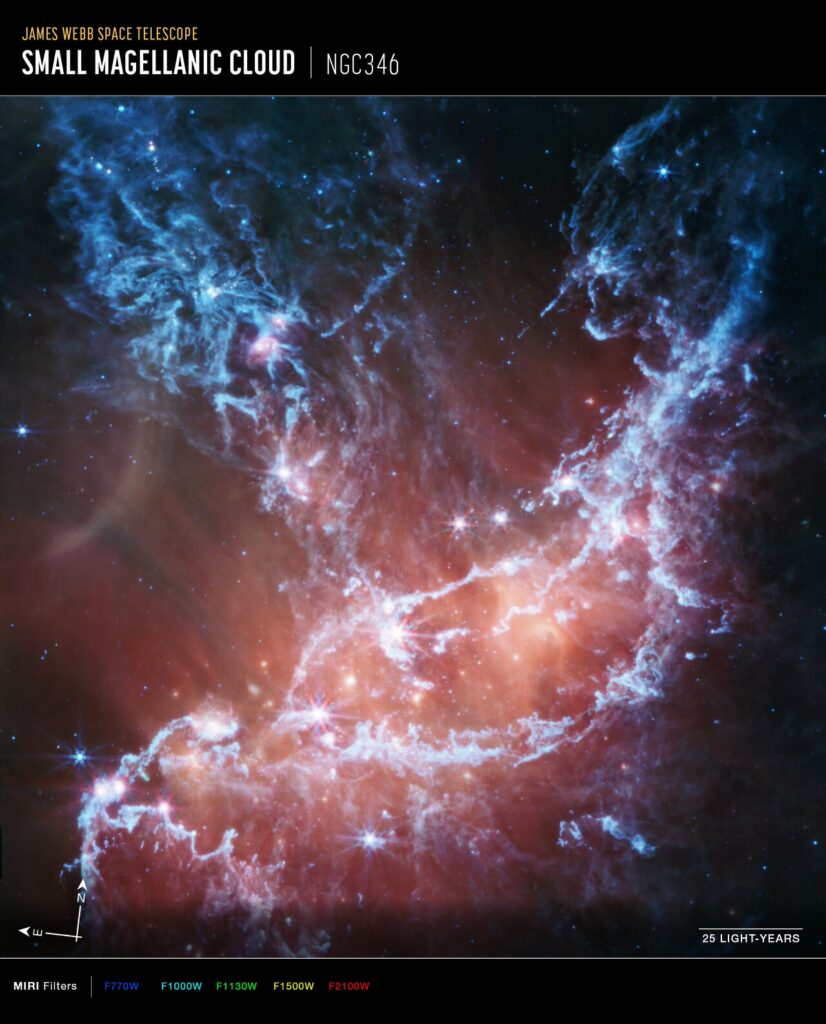Hubble spots stellar sculptors at work in a nearby galaxy: a new image of the star cluster NGC 346
In anticipation of the upcoming 35th anniversary of the NASA/ESA Hubble Space Telescope, ESA/Hubble is kicking off the celebrations with a new image of the star cluster NGC 346, featuring new data and processing techniques. This prolific star factory is in the Small Magellanic Cloud, one of the largest of the Milky Way’s satellite galaxies.
As part of ESA/Hubble’s 35th anniversary celebrations, a new image series is being shared to revisit stunning Hubble targets that were previously released. This image series combines new processing techniques with the latest data from Hubble to re-release these cosmic scenes for the public to enjoy.
This new image showcases the dazzling young star cluster NGC 346. Although several images of NGC 346 have been released previously, this view includes new data and is the first to combine Hubble observations made at infrared, optical, and ultraviolet wavelengths into an intricately detailed view of this vibrant star-forming factory.
NGC 346 is located in the Small Magellanic Cloud, a satellite galaxy of the Milky Way that lies 200 000 light-years away in the constellation Tucana. The Small Magellanic Cloud is less rich in elements heavier than helium — what astronomers call metals — than the Milky Way. This makes conditions in the galaxy similar to what existed in the early universe.
NGC 346 is home to more than 2500 newborn stars. The cluster’s most massive stars, which are many times more massive than our Sun, blaze with an intense blue light in this image. The glowing pink nebula and snakelike dark clouds are sculpted by the luminous stars in the cluster.
Hubble’s exquisite sensitivity and resolution were instrumental in uncovering the secrets of NGC 346’s star formation. Using two sets of observations taken 11 years apart, researchers traced the motions of NGC 346’s stars, revealing them to be spiralling in toward the centre of the cluster. This spiralling motion arises from a stream of gas from the outside of the cluster that fuels star formation in the centre of the turbulent cloud.
The inhabitants of this cluster are stellar sculptors, carving out a bubble from the nebula. NGC 346’s hot, massive stars produce intense radiation and fierce stellar winds that pummel the billowing gas of their birthplace and begin to disperse the surrounding nebula.
The nebula, named N66, is the brightest example of an H II (pronounced ‘H-two’) region in the Small Magellanic Cloud. H II regions are set aglow by ultraviolet light from hot young stars like those in NGC 346. The presence of the brilliant nebula indicates the young age of the star cluster, as an H II region shines only as long as the stars that power it — a mere few million years for the massive stars pictured here.
This image was developed from multiple Hubble observing programmes: #10248 (PI: Antonella Nota), #12940 (PI: Phillip Massey), #13680 (PI: Elena Sabbi), #15891 (PI: Claire Murray), and #17118 (PI: Claire Murray).

Press release from ESA Hubble.






